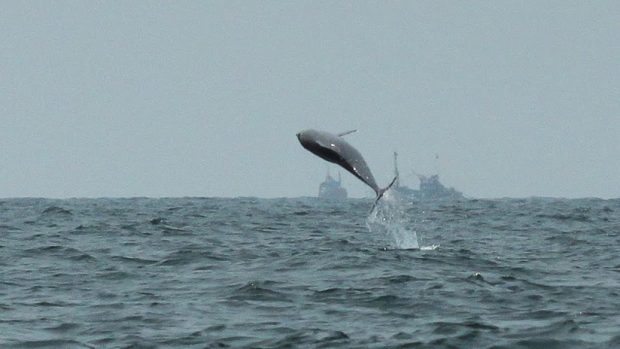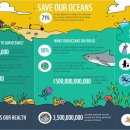Grants :: Small Grant Facilities :: Conservation of Grande & Bat Island Ecosystem in Goa
Conservation of Grande & Bat Island Ecosystem in Goa

Indo-Pacific Humpback Dolphins in the Mandovi Estuary, Mandovi estuary, Goa © WWF India, 2015
Objectives
The objectives of this project are to:
- Identify and assess the impacts of marine tourism activities in the Grande Island archipelago
- Develop guidelines and strategies for community-based sustainable marine tourism activities
- Enhance the capacity of key stakeholders for sustainable marine tourism
Background
Local community engagement and support, science-based management and monitoring are essential components of successful marine conservation initiatives. Whether people will continue to have access to sufficient and productive marine resources in the future depends on the way these resources are used and managed in the present. MFF and WWF-India envisage a gap analysis study to assess the impact of marine tourism activities on the Grande island archipelago and identify and assess the key threats. The study will inform guidelines/strategies for the development of community based marine tourism management. The project will also enhance capacities of stakeholder communities for sustainable tourism.
A range of anthropogenic and natural stressors currently affects the coastal habitats of the state of Goa. These have severe impacts on marine ecosystems, which support the majority of local livelihoods in the region, namely Tourism and Fisheries. The Goan coastal regions, till 1991, were the frenzied focus of development activities from five star resorts to aquaculture farms. The Coastal Regulation Zone (CRZ) notification now protects the area from the High Tide Line up to 500 meters, although it is regularly violated due to poor political governance in implementing the existing laws.
The corals and associated life forms in the coastal waters around Grande Island, off the coast of Goa, form a significant marine ecosystem, which is frequented by tourists in the State. Fishing boats use the waters around the island to wash and clean their fishing nets. Increasing anthropogenic stressors such as uncontrolled marine tourism activities, offshore garbage disposal, overfishing, untreated industrial and municipal effluents, discarded fishing nets, rampant coastal development and planned resurgence of mining activities have put this area at risk, largely due to ignorance and lack of regulation. It is therefore of utmost urgency and importance that the marine habitats, such as those of Grande Island, are prioritized and studied in order to protect the ecosystems and the livelihoods of the communities that are dependent on them.
Additionally, Dolphins have been sighted on a regular basis in small numbers at the mouths of the Mandovi and Zuari estuaries and along the stretch between Vasco and Grande Island. The number of dolphins sighted in the recent past has been as many as ten individuals in a day.
Target beneficiaries
The (direct and indirect) beneficiaries of this project are:
- Tourism Department, State of Goa
- Forest Department, State of Goa
- Dolphin boat operators
Outputs
The outputs of this project will be:
- An assessment and analysis of tourism related threats to the Grande Island marine ecosystem
- Development of guidelines and strategies to mitigate identified threats in consultation local communities and other stakeholders
- 40 Dolphin tour-boat operators made aware, and capacity build in implementing eco-friendly practices in dolphin watching
Accomplishments and challenges
Travel and Tourism in Goa contributes a share of 6.8% to India’s GDP. 3,76,640 foreign and 21,27,063 domestic tourists visited Goa in 2009. These numbers rose in 2010 to 4,41,053 and 22,01,752 foreign and domestic tourists respectively. While the majority of these tourists intend to holiday on the beaches of Goa, 2009-10 saw approximately 1,86,000 tourists, both foreign and domestic, exploring Wildlife Sanctuaries in the State. This number does not account for the tourists opting for marine eco-tourism activities such as dolphin watching and scuba diving.
As observed during the boat surveys conducted by the WWF-Goa team, there are approximately 150 boats being dispatched from Sinquerim Jetty and Coco Beach each and around 40 from Miramar. From these, some collectively conduct dolphin-watching and picnic/island boat tours, specifically from Sinquerim-Coco Beach, while those from Miramar conduct only dolphin-watching tours. During the peak season, each of these boats gets to go out into the sea at least once a day, meaning that there is a minimum of 700 boats encroaching dolphin habitat everyday between 9 a.m. and 5 p.m.
The coral reef around Grande Island is under threat from the activities of picnic/island boats in the area. Apart from the amount of garbage that is thrown into the water, anchor damage could be a serious problem, resulting in overturning and breakage of coral. The number of boats and the activities conducted at the island does not seem to be accounted for, and regulation needs to be enforced. Responsible and sustainable tourism is of paramount importance to an economy that is heavily dependent on tourism, like that of Goa. The number of people opting for dolphin watching trips and scuba diving, indicates that marine eco-tourism, if managed properly, is a potentially lucrative field. The resources on which this type of tourism depends, are very fragile, and extra care needs to be taken to ensure that the humpback dolphin and coral reefs are protected. While the dolphin population may appear to be stable at the moment, we cannot assume that boat activity has no bearing on their reproductive rate and life expectancy. Stress caused by the unregulated number and activities of these boats can result in dwindling populations. Similarly, unregulated boat traffic around Grande Island can result in coral damage to the point where the reef has no time to recover.
The study has advised policy recommendations, which have been disseminated to the Chief Ministry, Goa and the State Forest and Tourism Departments.
Contributions to cross-cutting themes
The project did not specifically address any of the cross cutting themes – it was predominantly a science research based study.
Lessons Learned
The challenges and issues related to marine tourism in Goa require inter-sectoral and multi-stakeholder dialogue and intervention. Solutions can only be achieved however, if there is political and community willingness to do so.
Project Facts
Country
Location
Mandovi and Sinquerim river estuary; Grande Island, Vasco Coast, Goa
Topic
- Capacity Building
- Coastal Governance
- Integrated Coastal Planning
- Sustainable Business Practices
- Sustainable Livelihoods
Duration
15th Jan 2015 to 15th Jan 2016
MFF Grant Amount
INR 982,000
Co-financing Partner
WWF - INR 582,849
Implementing Partner
Ms. Puja Mitra
Programme Manager, Goa Programme Office
World Wildlife Fund (WWF), India
Email: mitra.phase@gmail.com
Related Images
Related Publications

Promoting Sustainable Marine Tourism in Goa as part of the Mangroves for the Future (MFF) India initiative
Author: WWF India
Publisher: IUCN
Posted on: 12th May 2016
Category: SGF (Small Grant Facility)
Size: 29 MB




